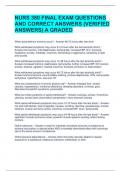NURS 380 FINAL EXAM QUESTIONS
AND CORRECT ANSWERS (VERIFIED
ANSWERS) A GRADED
When does delirium tremens occur? - Answer-48-72 hours after last drink
What withdrawal symptoms may occur 6-12 hours after the last alcoholic drink? -
Answer-fine tremors, mild diaphoresis, tachycardia, increased BP, N/V, anorexia,
headache, anxiety, irritability, insomnia, demanding or aggressive, sensitivity to light
and sounds
What withdrawal symptoms may occur 12-48 hours after the last alcoholic drink? -
Answer-increased tremors, diaphoresis, tachycardia, further increased BP, N/V worsen,
anxiety, distress, agitation, marked insomnia, transient confusion or hallucination
What withdrawal symptoms may occur 48-72 hours after the last alcoholic drink? -
Answer-tremors become uncontrollable shaking, profuse diaphoresis, HTN, tachycardia,
tachypnea, hyperthermia, seizures, DT
What are complications of chronic alcohol use? - Answer-enlarged liver, certain
cancers, hypertension, nutritional deficiency, bleeding disorders, cirrhosis, gout,
Wernicke-Korsakoff's syndrome, pancreatitis
What are initial symptoms of opioid withdrawal? - Answer-cravings, anxiety, rhinorrhea,
yawning, excess tears (lacrimation) perspiration, minor stomach cramps
What opioid withdrawal symptoms may occur 12-72 hours after the last dose? - Answer-
hot and cold flashes, loss of appetite, nausea, vomiting, diarrhea, goosebumps, muscle
twitched, muscle and bone aches, insomnia, increased BP, fever, tachycardia
What opioid withdrawal symptoms may occur 24-48 hours after the last dose? - Answer-
significant muscle and bone aches, powerful muscle spasms causing violent kicking
motions
Define tolerance. - Answer-a need for markedly increased amounts of substance to
achieve intoxication or desired effect AND a markedly diminished effect with continued
use of the same amount of substance
Define physical dependence. - Answer-when the body naturally adapts to regular
exposure to a substance, leading to tolerance, withdrawal, or both.
, Define withdrawal. - Answer-the occurrence of physical or emotional clinical
manifestations if the substance is decreased or abruptly stopped
How do you interpret the results of the CAGE questionnaire? - Answer-1 yes = needs
closer assessment
2 yes = highly correlated w/ alcohol use disorder
What are possible causes of hypervolemia? - Answer-increased sodium and water
retention, cirrhosis, heart failure, stress conditions, corticosteroid use, high sodium
intake
What lab values should be assessed in hypo and hypervolemia? - Answer-electrolytes,
Hgb, Hct, serum osmolality, BUN, creatinine, urine specific gravity, urine osmolality
What 2 conditions are included in COPD and what are the main clinical manifestations?
- Answer-emphysema and chronic bronchitis
increased work of breathing, shortness of breath
What are clinical manifestations of emphysema? - Answer-(pink puffer) thin, barrel
chest, reddish complexion, puffing when breathing
What are clinical manifestations of chronic bronchitis? - Answer-(blue bloater) obese,
hypoxemia, cyanotic, productive cough, excess mucus production
Why might someone use a spacer/Aerochamber with a metered dose inhaler (MDI)? -
Answer-if they are incapable of accurately counting the inhales (spacer gives more time
to breath in) (children, etc.)
What are the steps to using a metered dose inhaler (MDI)? - Answer-1. remove cap and
shake inhaler
2. exhale gently
3. put mouthpiece IN your mouth
4. press canister down at start of inhale
5. inhale deeply
6. hold breath for 10 seconds
7. breathe out slowly
8. wait 1 minute before repeating




